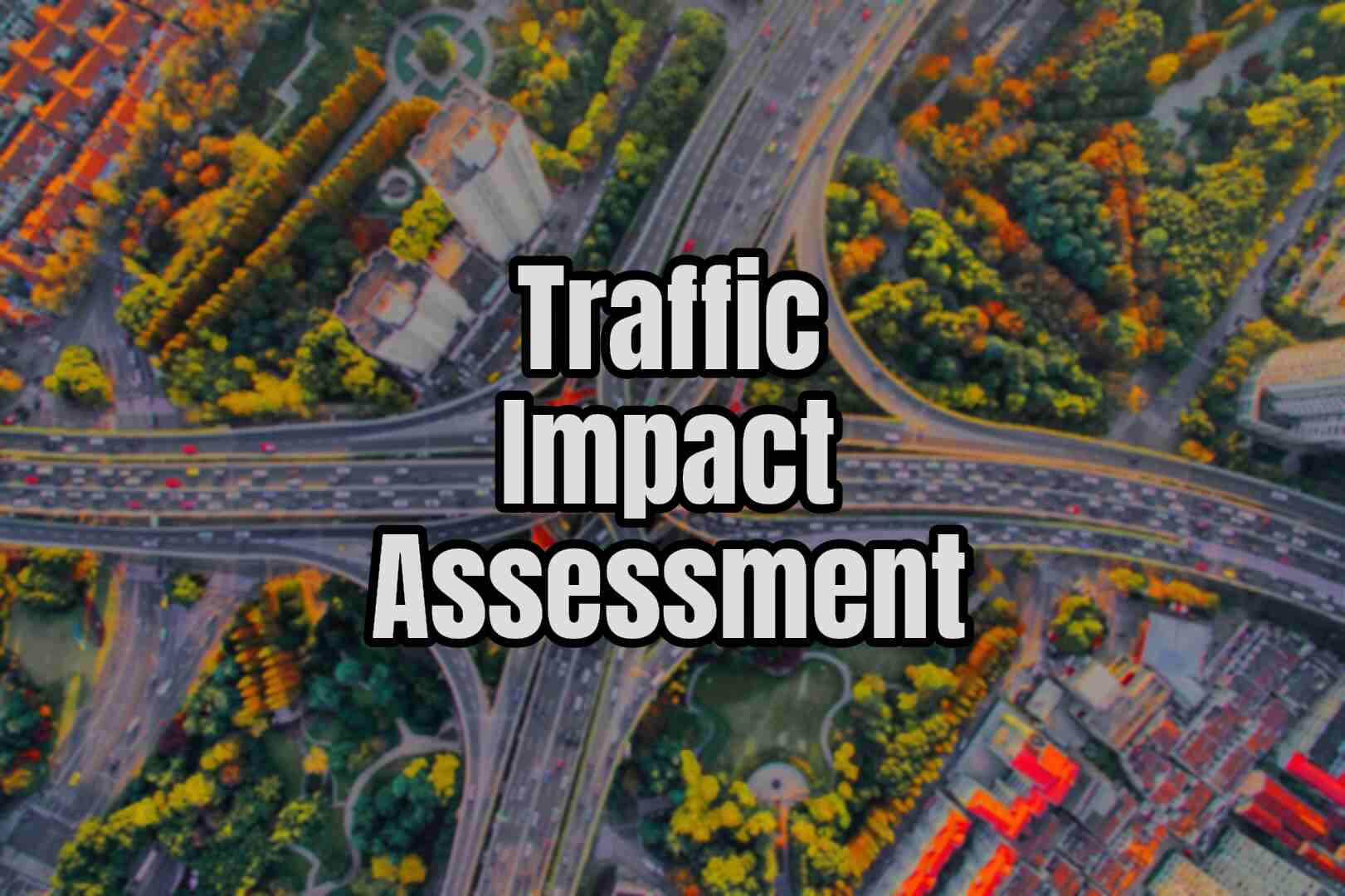What is Traffic Impact Assessment? Key Insights for Planners
When cities grow, so does the traffic. It’s a simple fact of urban life. But how do planners make sure new developments don’t lead to clogged streets, accidents, and overall chaos? That’s where a Traffic Impact Assessment (TIA) comes in. It’s a smart tool that helps everyone, from city officials to developers, figure out how a new project will affect the local roadways and whether the existing infrastructure can handle the extra vehicles. In this article, we’ll break down what a TIA is, why it’s essential, and how it fits into the broader planning picture.
What is a Traffic Impact Assessment (TIA)?
A Traffic Impact Assessment (TIA) is like a blueprint for understanding how new developments affect traffic. Whether it’s a new shopping center, a residential complex, or a big office building, these kinds of projects can bring a lot more cars to the area. The TIA digs deep into how much more traffic will be on the road, how it will affect traffic flow, and what changes are needed to make sure everyone can still get where they need to go — safely and quickly.
TIAs typically assess things like:
- Traffic volume (How many cars will be on the road?)
- Road capacity (Can the roads handle all those extra cars?)
- Safety risks (Are there any areas where accidents are more likely?)
- Congestion points (Where might traffic bottlenecks form?)
- Pedestrian considerations (Are the sidewalks safe and accessible?)
At the end of the day, a TIA helps planners, developers, and local authorities make sure that growth doesn’t lead to gridlock. In fact, a well-conducted traffic impact study can prevent future traffic nightmares before they even start.
Why Do Planners Need Traffic Impact Assessments?
So, why are Traffic Impact Assessments so important? Good question. Let’s take a look at a few reasons:
1. Managing Traffic Flow
Without a solid TIA, a new development could lead to traffic jams, making it harder for everyone to get where they need to go. By assessing how a project will impact traffic patterns, planners can take proactive steps to improve traffic flow. This might mean adding extra lanes, putting in traffic signals, or upgrading intersections. If traffic can flow smoothly, everyone’s day gets a little bit easier.
2. Improving Safety
When traffic increases, safety can become a concern. More cars on the road means more potential for accidents. But a good TIA doesn’t just look at cars — it also considers pedestrian safety. After all, pedestrians and cyclists have to share the road too. A TIA can suggest adding crosswalks, pedestrian bridges, or even traffic calming measures like speed bumps to reduce the risk of accidents.
3. Protecting the Environment
We all know that more cars mean more pollution. Congested streets with idling cars are a huge source of air pollution. By using a traffic impact study, planners can identify ways to reduce congestion and encourage greener alternatives like public transport, cycling, or walking. The goal is to minimize the environmental footprint of a new development while still allowing the city to grow.
4. Sustaining Infrastructure
Not every road is built to handle a surge in traffic. A TIA helps planners determine if the local infrastructure needs to be upgraded. Sometimes that means widening roads or adding new lanes. Other times, it could mean adding or improving public transportation options. Whatever the case, a TIA helps planners make informed decisions, saving money in the long run by avoiding unnecessary overhauls.
Read Also: SSIS 858: Optimizing Data Integration
How Does a Traffic Impact Assessment Work?
You might be wondering how exactly a Traffic Impact Assessment is conducted. It’s not just about guessing how much traffic a new development will bring. Here’s a step-by-step breakdown:
1. Data Collection
The first step in any TIA is gathering data. This means looking at how traffic currently flows through the area, how busy the roads are at different times of the day, and identifying any traffic bottlenecks or accidents. Planners might use traffic counts, traffic cameras, and even satellite data to get an accurate picture.
2. Traffic Modeling and Analysis
Once the data is in, it’s time for analysis. Engineers use modeling software to predict what will happen once the new development opens. The model simulates traffic flow, taking into account how many cars will come and go, peak traffic hours, and the capacity of surrounding roads and intersections. This is the heart of the Traffic Impact Analysis — it gives planners a clear view of how things are going to change.
3. Identifying Issues
The analysis may show that certain roads or intersections won’t be able to handle the increased traffic. Planners will highlight these potential problem spots and look for ways to fix them. For example, they might suggest adding a new traffic signal, redesigning a dangerous intersection, or even rerouting traffic to reduce congestion.
4. Proposing Solutions
Once the problem areas are identified, it’s time to come up with solutions. Sometimes that means making physical changes to the infrastructure — widening roads, adding lanes, or even building new roads. But it could also mean encouraging alternative transportation options, like buses or bike lanes, to reduce the number of cars on the road.
5. Report and Recommendations
After all the analysis is done, the results are put together into a report. This report details the findings of the traffic impact study, the proposed mitigation measures, and any recommendations for improving the infrastructure. This report is submitted to local authorities for approval.
Traffic Impact Analysis vs. Traffic Impact Study: What’s the Difference?
You might come across the terms Traffic Impact Analysis and Traffic Impact Study often, and while they’re closely related, there is a subtle difference.
- Traffic Impact Analysis refers to the actual analysis process — the data collection, modeling, and evaluation of how traffic will be affected by the new development.
- Traffic Impact Study is the final document that results from the analysis. It includes the findings, proposed changes, and mitigation strategies.
In short, the analysis is the process, and the study is the report.
How Does a Traffic Impact Assessment Benefit Everyone?
1. For Developers
Developers benefit from TIAs because they provide a roadmap for addressing traffic-related issues before the construction starts. This means fewer delays, fewer costly surprises, and smoother project approval. Developers can also show local authorities that they’re taking steps to mitigate traffic impacts, which can help get their projects approved faster.
2. For Local Authorities
For local governments, TIAs are a vital tool for ensuring that city growth is sustainable. They help decision-makers understand the potential consequences of new developments, so they can plan for the future and make the necessary infrastructure improvements.
3. For Residents
For the people who live and work in the area, TIAs ensure that traffic doesn’t get out of control. These assessments help prevent congestion, improve safety, and protect the environment, which all leads to a better quality of life.
Conclusion
In conclusion, a Traffic Impact Assessment is more than just a technical report — it’s a tool that helps cities grow smarter. By analyzing the potential effects of new developments on traffic, planners can make informed decisions that ensure smooth traffic flow, enhance safety, and protect the environment. Whether you’re a developer, planner, or local official, understanding and conducting a TIA is crucial for creating efficient, sustainable urban spaces.
So, next time a big development comes to town, rest assured that a Traffic Impact Assessment is on the job, helping to keep traffic moving and making sure that growth doesn’t lead to gridlock.
FAQs
1. What is the main purpose of a Traffic Impact Assessment?
The main goal of a TIA is to evaluate how a new development will affect traffic in the area and recommend changes to improve traffic flow and safety.
2. How long does it take to conduct a Traffic Impact Study?
The timeline can vary, but a typical traffic impact study can take anywhere from a few weeks to a few months, depending on the size of the development and the complexity of the area.
3. Are Traffic Impact Assessments required for all developments?
While not every small project requires a TIA, larger developments like shopping centers, apartment buildings, or industrial parks usually do.
4. Who conducts a Traffic Impact Assessment?
Traffic engineers, urban planners, and transportation consultants are responsible for conducting TIAs and analyzing the results.
5. What happens if a Traffic Impact Assessment identifies major problems?
If the TIA identifies traffic problems, the planner will propose mitigation strategies like adding lanes, improving traffic signals, or implementing public transport options to alleviate congestion.





